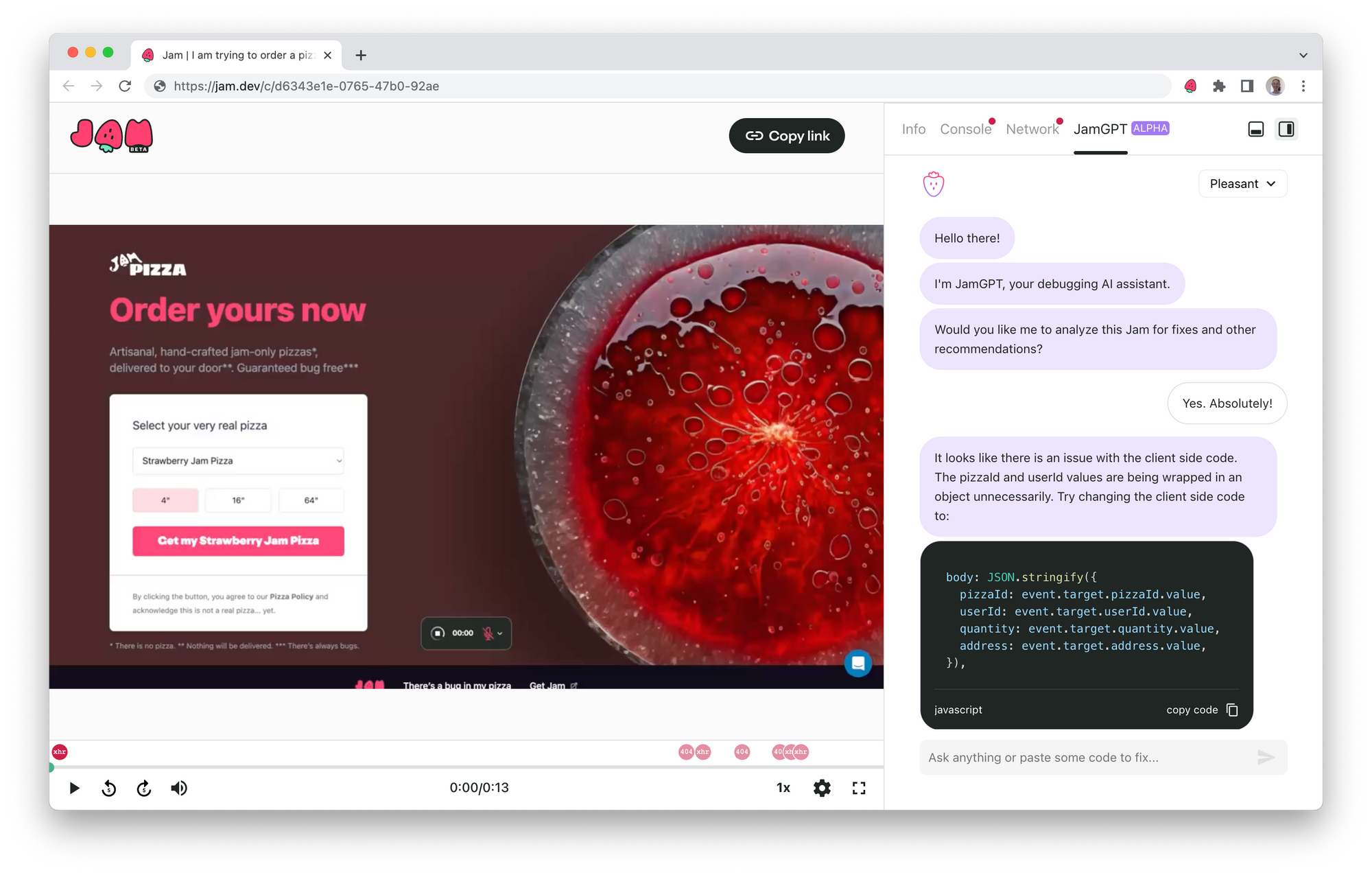Introducing JamGPT – your AI debugging assistant
Today, we're excited to announce JamGPT, a new AI debugging assistant that helps you fix bugs faster.
While most things in product development have changed 100x since the 1990’s, how we report bugs has not.
So we started a company to change that, and bring the forgotten but essential process of catching and fixing bugs from the 1990’s into the future.
And when we saw what was now possible with AI 🤯, we knew we had to find a way to bring it to you in Jam.
And that’s when we started building JamGPT...
Where AI powered debugging leads
Jam currently supports developers during the code review and testing cycles by capturing bug diagnostic data and instantly replaying the bug to seamlessly identify what needs to be fixed.
But what would it look like if an AI powered debugging assistant took over the next steps to suggest where to look to fix the bug or even fix code for you?
Over numerous conversations with developers about the future of debugging, we started to hear two things come up over and over again... and those became the principles that led to JamGPT.
1. In the future, debugging doesn’t involve Google search or Stack Overflow
AI means you don't have to search.
With AI, the full knowledge of the internet is available and the right answer for your exact context comes to you. No search needed.
Developers that are partnering with AI are doing fewer searches and receiving more contextually relevant suggestions.
What we’ve heard from developers who are using Copilot to write code is that having those AI assistants right in your code editor means you have to do a lot fewer searches. Instead of searching through API documentation or looking up syntax or what library to use, Copilot can just suggest it for you.
This is also where we see the future of debugging.
In today’s world, debugging moves at the speed of Google searches and opening Stack Overflow tabs. But in tomorrow’s world, with AI tools like JamGPT – AI assistants that are right there in the console logs, and in the bug report itself, will allow for AI to incorporate the relevant context you need when a bug occurs. Instead needing to search for what the errors mean and what to do about them, the solution will get suggested right there.
In 2022: debugging = google searching.
In 2023: debugging = auto-suggested.
JamGPT follows this route: while before, you needed to search for errors, JamGPT is right there in the bug report with all the context to offer you a personal suggestion.
2. In 2023, AI is not a 10x software engineer; it’s an AI–human collaboration that’s a true 10x engineer
One day, AI may write all software, but we are still a long way away from that.
Developers using Copilot are finding that while it’s great at generating code, it’s still taking human experience, intuition, and curation to bring the suggested code to a helpful state, especially in complex and large codebases.
As you know, codebases are complicated and applications consist of many different running services. While AI is good at the file level, it still isn’t good enough at the application level.
In an amazing Wired interview, world chess champion Gary Kasparov said, “With AlphaZero and future machines, I describe the human role as being shepherds. You just have to nudge the flock of intelligent algorithms. Just basically push them in one direction or another, and they will do the rest of the job. You put the right machine in the right space to do the right task.”
We see this as a similar metaphor for how developers are interacting with AI. Those who learn to leverage AI can 10x their effectiveness. It’s a true collaboration: human plus machine that's making leaps and bounds in productivity and yielding results.
JamGPT is built on this premise. While we will keep working hard to do more to offer the fix right away to engineers, it still requires insight, knowledge and curation on the software engineer’s part to know how to incorporate fixes and suggestions from JamGPT into practice.
In future versions, we believe we will be able to search your codebase through your GitHub repo or the sourcemaps for the broken code and offer the fix automatically, but with limited tokens per conversation available in GPT-3.5 we cannot do that yet. We are currently on the GPT-4 waitlist and once we have access to the 32k token limit of GPT-4 we are excited to try and offer a code fix outright.
This may also enable the model to identify more complex bugs that happen across multiple files of a large codebase and suggest appropriate fixes, making the debugging process even more efficient for developers.
A Closer Look at JamGPT: AI in Bug Tickets
When your team reports bugs with Jam, not only do you get the console logs, network requests, device info, and session replay for every bug, you now also get an AI helper inside the bug ticket, suggesting fixes.
JamGPT has all the context of the browser during the bug (because it is fed with data from the Jam). And then it saves you some Google searches and suggests to you some fixes. Then you can give it the broken code and it will rewrite it with the fix.

JamGPT offers the following functionalities to simplify the debugging process:
- Pull insights directly from the bug report – Bug diagnostic data will feed JamGPT for the most contextually relevant code suggestions, so you don’t have to search Stack Overflow 😲
- Fix buggy code – JamGPT will suggest code fixes across infrastructure, styling and logic issues. Whatever your website is built in, you can receive a suggested fix.
- Chat with you as an AI pair debugger – In a seamless chat interface that allows ongoing conversation with customized verbosity, depending if you want detailed explanations or quick TLDRs. It can even insult you, if you want 🙂
- Generate PR descriptions – Before you submit the PR, JamGPT can automatically generate the description of the fix that you share in a pull request. One less writing task on your plate!
This is just the beginning
We are committed to continuing to improve JamGPT in the coming months to bring bug reporting out of its archaic 1990’s roots and into a better, more productive future.
Kudos to the amazing hard work by the team who built it. Curious to learn more about how JamGPT was built? We'll be publishing a blog post with all the nitty gritty technical details soon.
Experience JamGPT at no cost
JamGPT is free. We believe in advancing bug reporting and bringing it to everyone for free. You can check out JamGPT here.
